Toyota Recall Problems: Analyzing Social Networks and Digitization
VerifiedAdded on 2023/06/15
|5
|1084
|84
Case Study
AI Summary
This case study delves into the challenges faced by Toyota due to recall problems, the influence of social networks, and the increasing digitization of the automotive industry. The study highlights the product harm crisis resulting from publicized defects and the impact on Toyota's reputation. It discusses how Toyota's past successes with Total Quality Control (TQC) were overshadowed by recall-related safety concerns and the role of social media in amplifying the crisis. The analysis recommends that Toyota prioritize regaining public trust through timely voluntary recalls and emphasize its contributions to society, given the intense competition and potential financial repercussions. The case emphasizes the need for strategic social media management to protect Toyota's reputation and navigate the evolving digital landscape.
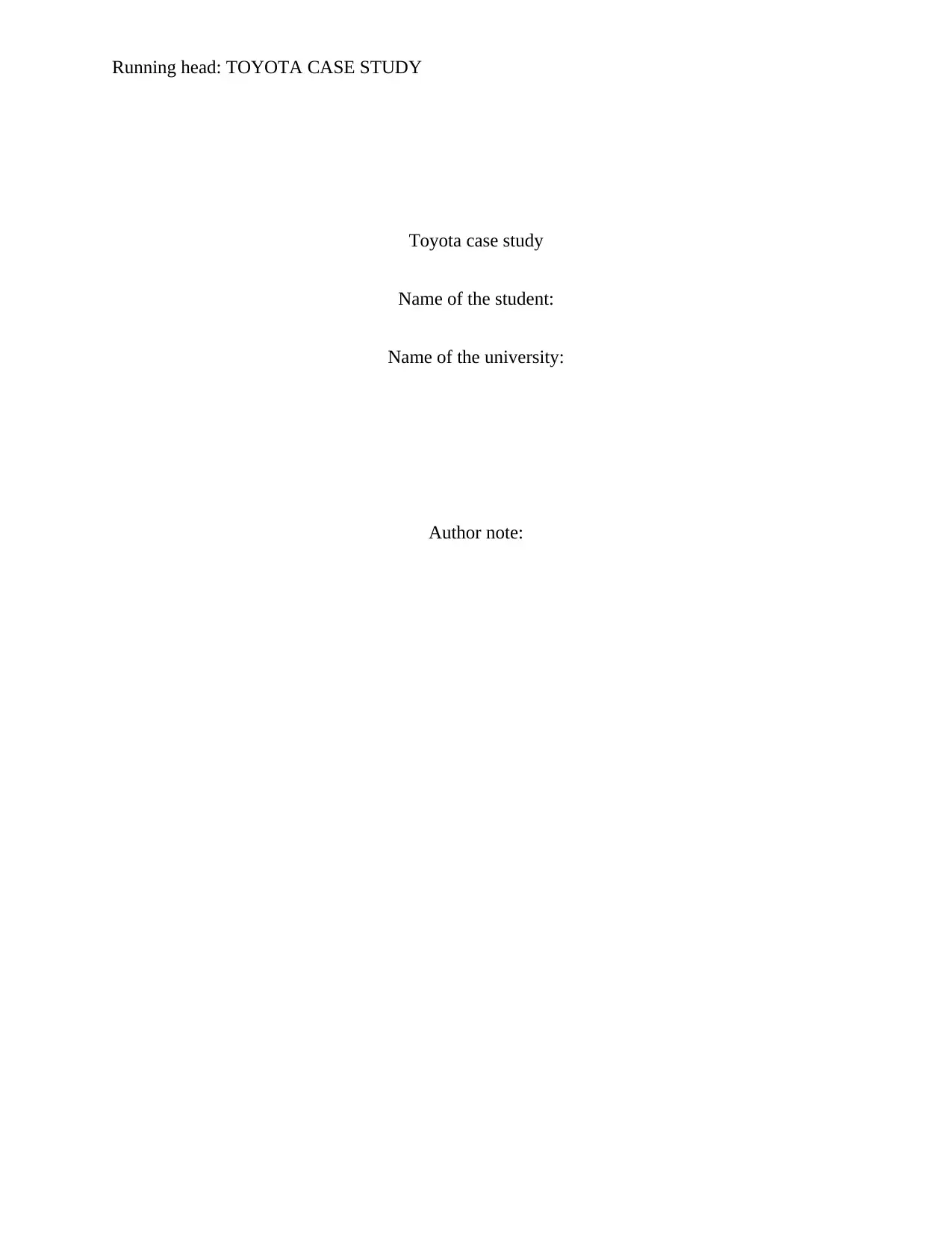
Running head: TOYOTA CASE STUDY
Toyota case study
Name of the student:
Name of the university:
Author note:
Toyota case study
Name of the student:
Name of the university:
Author note:
Paraphrase This Document
Need a fresh take? Get an instant paraphrase of this document with our AI Paraphraser
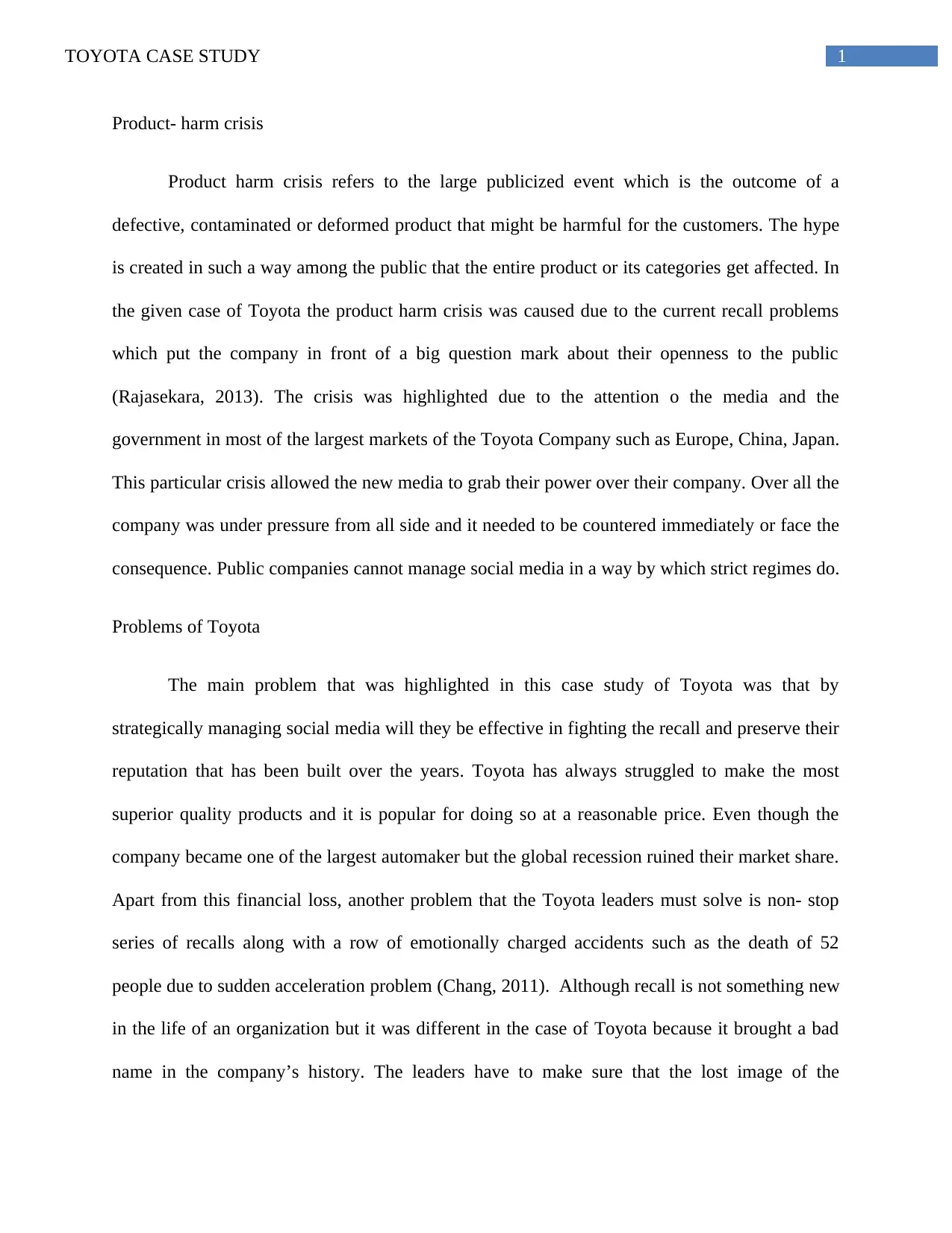
1TOYOTA CASE STUDY
Product- harm crisis
Product harm crisis refers to the large publicized event which is the outcome of a
defective, contaminated or deformed product that might be harmful for the customers. The hype
is created in such a way among the public that the entire product or its categories get affected. In
the given case of Toyota the product harm crisis was caused due to the current recall problems
which put the company in front of a big question mark about their openness to the public
(Rajasekara, 2013). The crisis was highlighted due to the attention o the media and the
government in most of the largest markets of the Toyota Company such as Europe, China, Japan.
This particular crisis allowed the new media to grab their power over their company. Over all the
company was under pressure from all side and it needed to be countered immediately or face the
consequence. Public companies cannot manage social media in a way by which strict regimes do.
Problems of Toyota
The main problem that was highlighted in this case study of Toyota was that by
strategically managing social media will they be effective in fighting the recall and preserve their
reputation that has been built over the years. Toyota has always struggled to make the most
superior quality products and it is popular for doing so at a reasonable price. Even though the
company became one of the largest automaker but the global recession ruined their market share.
Apart from this financial loss, another problem that the Toyota leaders must solve is non- stop
series of recalls along with a row of emotionally charged accidents such as the death of 52
people due to sudden acceleration problem (Chang, 2011). Although recall is not something new
in the life of an organization but it was different in the case of Toyota because it brought a bad
name in the company’s history. The leaders have to make sure that the lost image of the
Product- harm crisis
Product harm crisis refers to the large publicized event which is the outcome of a
defective, contaminated or deformed product that might be harmful for the customers. The hype
is created in such a way among the public that the entire product or its categories get affected. In
the given case of Toyota the product harm crisis was caused due to the current recall problems
which put the company in front of a big question mark about their openness to the public
(Rajasekara, 2013). The crisis was highlighted due to the attention o the media and the
government in most of the largest markets of the Toyota Company such as Europe, China, Japan.
This particular crisis allowed the new media to grab their power over their company. Over all the
company was under pressure from all side and it needed to be countered immediately or face the
consequence. Public companies cannot manage social media in a way by which strict regimes do.
Problems of Toyota
The main problem that was highlighted in this case study of Toyota was that by
strategically managing social media will they be effective in fighting the recall and preserve their
reputation that has been built over the years. Toyota has always struggled to make the most
superior quality products and it is popular for doing so at a reasonable price. Even though the
company became one of the largest automaker but the global recession ruined their market share.
Apart from this financial loss, another problem that the Toyota leaders must solve is non- stop
series of recalls along with a row of emotionally charged accidents such as the death of 52
people due to sudden acceleration problem (Chang, 2011). Although recall is not something new
in the life of an organization but it was different in the case of Toyota because it brought a bad
name in the company’s history. The leaders have to make sure that the lost image of the
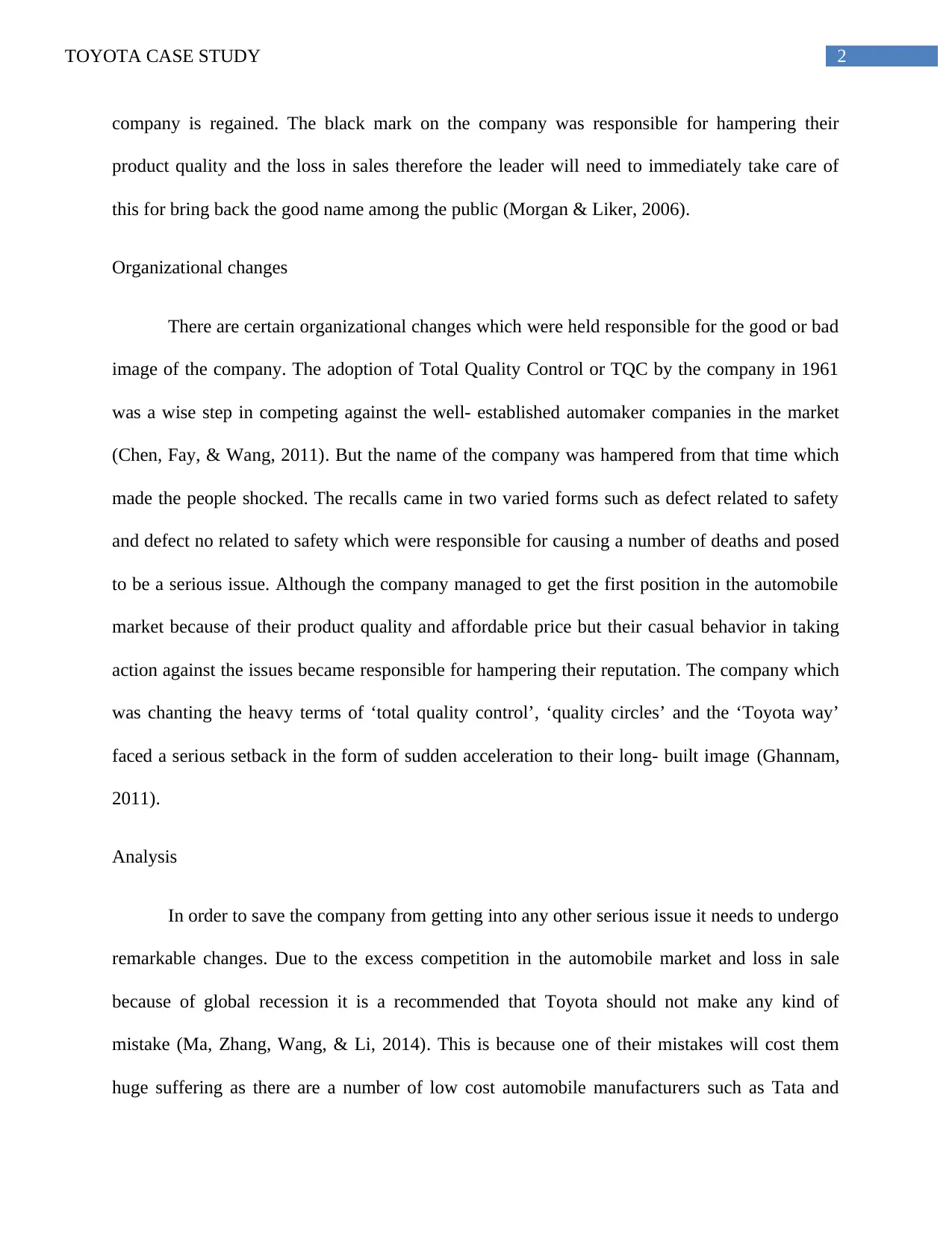
2TOYOTA CASE STUDY
company is regained. The black mark on the company was responsible for hampering their
product quality and the loss in sales therefore the leader will need to immediately take care of
this for bring back the good name among the public (Morgan & Liker, 2006).
Organizational changes
There are certain organizational changes which were held responsible for the good or bad
image of the company. The adoption of Total Quality Control or TQC by the company in 1961
was a wise step in competing against the well- established automaker companies in the market
(Chen, Fay, & Wang, 2011). But the name of the company was hampered from that time which
made the people shocked. The recalls came in two varied forms such as defect related to safety
and defect no related to safety which were responsible for causing a number of deaths and posed
to be a serious issue. Although the company managed to get the first position in the automobile
market because of their product quality and affordable price but their casual behavior in taking
action against the issues became responsible for hampering their reputation. The company which
was chanting the heavy terms of ‘total quality control’, ‘quality circles’ and the ‘Toyota way’
faced a serious setback in the form of sudden acceleration to their long- built image (Ghannam,
2011).
Analysis
In order to save the company from getting into any other serious issue it needs to undergo
remarkable changes. Due to the excess competition in the automobile market and loss in sale
because of global recession it is a recommended that Toyota should not make any kind of
mistake (Ma, Zhang, Wang, & Li, 2014). This is because one of their mistakes will cost them
huge suffering as there are a number of low cost automobile manufacturers such as Tata and
company is regained. The black mark on the company was responsible for hampering their
product quality and the loss in sales therefore the leader will need to immediately take care of
this for bring back the good name among the public (Morgan & Liker, 2006).
Organizational changes
There are certain organizational changes which were held responsible for the good or bad
image of the company. The adoption of Total Quality Control or TQC by the company in 1961
was a wise step in competing against the well- established automaker companies in the market
(Chen, Fay, & Wang, 2011). But the name of the company was hampered from that time which
made the people shocked. The recalls came in two varied forms such as defect related to safety
and defect no related to safety which were responsible for causing a number of deaths and posed
to be a serious issue. Although the company managed to get the first position in the automobile
market because of their product quality and affordable price but their casual behavior in taking
action against the issues became responsible for hampering their reputation. The company which
was chanting the heavy terms of ‘total quality control’, ‘quality circles’ and the ‘Toyota way’
faced a serious setback in the form of sudden acceleration to their long- built image (Ghannam,
2011).
Analysis
In order to save the company from getting into any other serious issue it needs to undergo
remarkable changes. Due to the excess competition in the automobile market and loss in sale
because of global recession it is a recommended that Toyota should not make any kind of
mistake (Ma, Zhang, Wang, & Li, 2014). This is because one of their mistakes will cost them
huge suffering as there are a number of low cost automobile manufacturers such as Tata and
⊘ This is a preview!⊘
Do you want full access?
Subscribe today to unlock all pages.

Trusted by 1+ million students worldwide
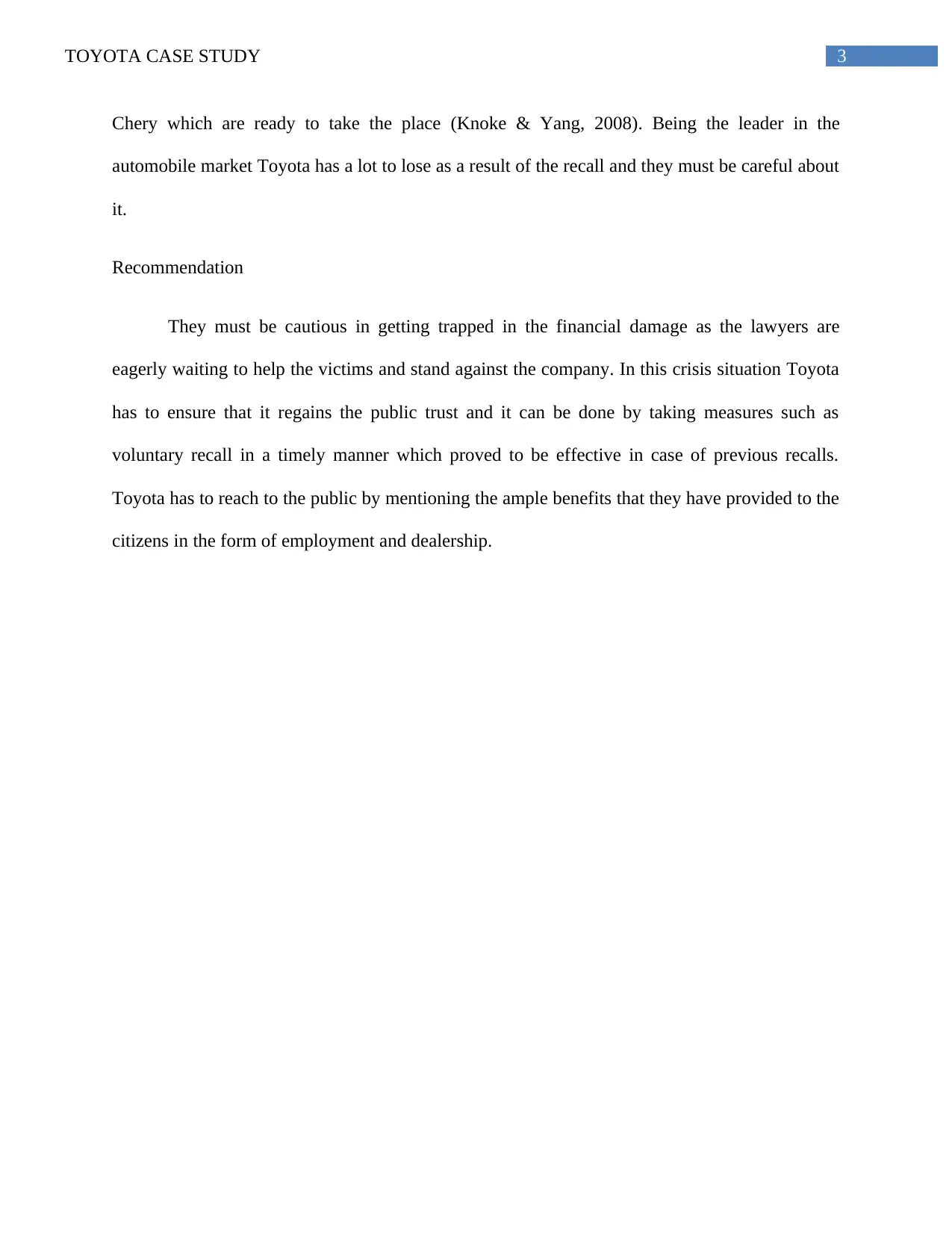
3TOYOTA CASE STUDY
Chery which are ready to take the place (Knoke & Yang, 2008). Being the leader in the
automobile market Toyota has a lot to lose as a result of the recall and they must be careful about
it.
Recommendation
They must be cautious in getting trapped in the financial damage as the lawyers are
eagerly waiting to help the victims and stand against the company. In this crisis situation Toyota
has to ensure that it regains the public trust and it can be done by taking measures such as
voluntary recall in a timely manner which proved to be effective in case of previous recalls.
Toyota has to reach to the public by mentioning the ample benefits that they have provided to the
citizens in the form of employment and dealership.
Chery which are ready to take the place (Knoke & Yang, 2008). Being the leader in the
automobile market Toyota has a lot to lose as a result of the recall and they must be careful about
it.
Recommendation
They must be cautious in getting trapped in the financial damage as the lawyers are
eagerly waiting to help the victims and stand against the company. In this crisis situation Toyota
has to ensure that it regains the public trust and it can be done by taking measures such as
voluntary recall in a timely manner which proved to be effective in case of previous recalls.
Toyota has to reach to the public by mentioning the ample benefits that they have provided to the
citizens in the form of employment and dealership.
Paraphrase This Document
Need a fresh take? Get an instant paraphrase of this document with our AI Paraphraser
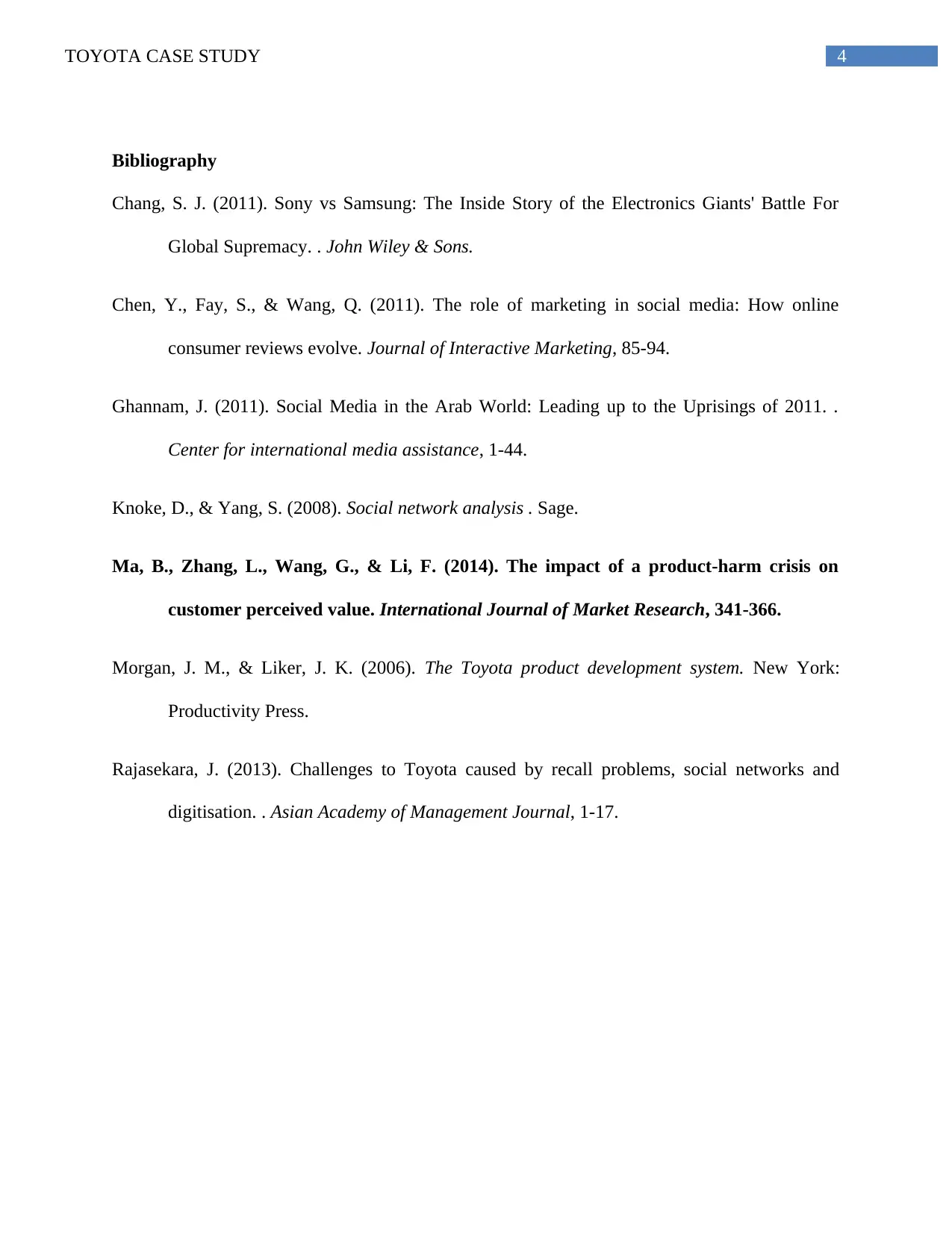
4TOYOTA CASE STUDY
Bibliography
Chang, S. J. (2011). Sony vs Samsung: The Inside Story of the Electronics Giants' Battle For
Global Supremacy. . John Wiley & Sons.
Chen, Y., Fay, S., & Wang, Q. (2011). The role of marketing in social media: How online
consumer reviews evolve. Journal of Interactive Marketing, 85-94.
Ghannam, J. (2011). Social Media in the Arab World: Leading up to the Uprisings of 2011. .
Center for international media assistance, 1-44.
Knoke, D., & Yang, S. (2008). Social network analysis . Sage.
Ma, B., Zhang, L., Wang, G., & Li, F. (2014). The impact of a product-harm crisis on
customer perceived value. International Journal of Market Research, 341-366.
Morgan, J. M., & Liker, J. K. (2006). The Toyota product development system. New York:
Productivity Press.
Rajasekara, J. (2013). Challenges to Toyota caused by recall problems, social networks and
digitisation. . Asian Academy of Management Journal, 1-17.
Bibliography
Chang, S. J. (2011). Sony vs Samsung: The Inside Story of the Electronics Giants' Battle For
Global Supremacy. . John Wiley & Sons.
Chen, Y., Fay, S., & Wang, Q. (2011). The role of marketing in social media: How online
consumer reviews evolve. Journal of Interactive Marketing, 85-94.
Ghannam, J. (2011). Social Media in the Arab World: Leading up to the Uprisings of 2011. .
Center for international media assistance, 1-44.
Knoke, D., & Yang, S. (2008). Social network analysis . Sage.
Ma, B., Zhang, L., Wang, G., & Li, F. (2014). The impact of a product-harm crisis on
customer perceived value. International Journal of Market Research, 341-366.
Morgan, J. M., & Liker, J. K. (2006). The Toyota product development system. New York:
Productivity Press.
Rajasekara, J. (2013). Challenges to Toyota caused by recall problems, social networks and
digitisation. . Asian Academy of Management Journal, 1-17.
1 out of 5
Related Documents
Your All-in-One AI-Powered Toolkit for Academic Success.
+13062052269
info@desklib.com
Available 24*7 on WhatsApp / Email
![[object Object]](/_next/static/media/star-bottom.7253800d.svg)
Unlock your academic potential
Copyright © 2020–2025 A2Z Services. All Rights Reserved. Developed and managed by ZUCOL.





